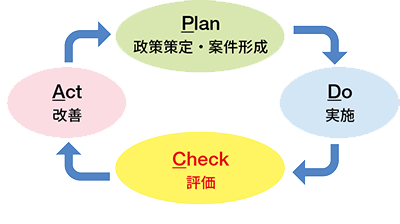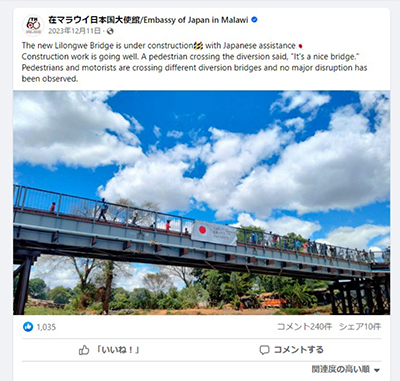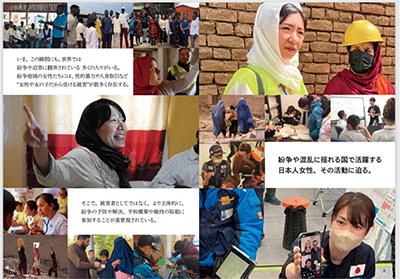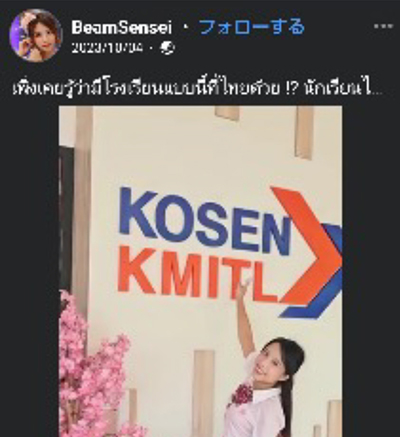Column
Recommendations and Initiatives Related to Strengthening Publicity of Japan’s ODA
In the “Review of Japan’s ODA Evaluations from FY 2015 to FY 2021” conducted by MOFA in FY2022, items related to “Information disclosure and promoting understanding of the public and the international community” ranked fourth among the recommendations and lessons learned extracted from the evaluation reports subjected to review. Among these, more than 80% were identified to be related to strengthening the publicity of Japan’s ODA.Note 1 In particular, it has been pointed out that there is inadequate awareness among partner countries and other donors of Japan’s ODA track record, achievements, and comparative advantage in specific fields. Of the FY2022 and FY2023 ODA project evaluations that are published on p. 27-33 of this report, recommendations on publicity and information disclosure were raised for six evaluations in total.
The Development Cooperation Charter revised in June 2023 states that the public’s understanding and support are essential to implement development cooperation. Therefore, in addition to disclosing information on the implementation status and evaluation of development cooperation to the public widely, promptly, and with sufficient transparency, Japan will also actively engage in public relations abroad to make Japan’s development cooperation and its achievements better known and understood by the international community including developing countries.
ODA evaluation corresponds to “Check” (“C”) in the PDCA cycle for ODA, and the results of evaluation are reflected in policy formulation and project formation by MOFA and JICA. This column provides an overview of the actions and initiatives in response to recommendations and lessons drawn from third-party evaluation, in relation to strengthening the publicity of Japan’s ODA.

PDCA cycle
1. The need for publicity and information disclosure in Japan
With regard to the approach to publicity and information disclosure, it was pointed out in the FY2023 ODA evaluation that the way in which information is disclosed needs to be improved so that the general public can easily understand what kind of assistance Japan is providing to Egypt, and why. By highlighting projects that are of interest to the public, the interconnections among schemes such as ODA loans, grant assistance, and technical cooperation should be communicated in an easy-to-understand manner (“Evaluation of Japan’s ODA to the Arab Republic of Egypt”). Furthermore, it was recommended that, “To promote public understanding of ODA’s support for refugees and to attract private funds, it is necessary to publicize the overall picture of Japan’s efforts, including the support provided through international organizations and their relationship with other Japanese cooperation efforts in an easy-to-understand manner“ (“Evaluation of Japan’s ODA to Forcibly Displaced Persons and Host Countries”).
Similar recommendations have also been made in the past. For example, “it would have been desirable to use effective and attractive public relations with a clear narrative in connection with the overall picture, such as the framework of Middle East diplomacy, human security initiatives including refugee support and humanitarian assistance, and the history of bilateral relations with Jordan,”Note 2 and “It is recommended that MOFA more proactively disseminates information on its projects in order to ensure transparency in ODA and to promote public understanding.”Note 3
Moreover, it has also been repeatedly pointed out, in particular, that the objectives and contents of assistance under the Grant Aid for the Economic and Social Development Programme implemented by MOFA, are difficult to understand.Note 4
In response to such recommendations, MOFA and JICA are putting effort into disseminating information and publicizing Japan’s development cooperation with Egypt in an easy-to-understand manner for the general public. In particular, they use their ODA websites and social media accounts to raise awareness about the interconnections among schemes such as ODA loans, grant assistance, and technical cooperation in Egypt.
As for Japan’s ODA to Forcibly Displaced Persons and Host Countries, efforts are made to publicize Japan’s support to refugees in cooperation with international organizations as well as Japanese NGOs, corporations, and local governments. JICA has produced pamphlets (in both Japanese and English) about supporting refugees through development cooperation to raise awareness, and plans to boost opportunities for exchanges of opinions with private corporations and NGOs.
An ongoing initiative in Rwanda is the publication of information on Japan’s ODA to Rwanda on the website of the Embassy of Japan in Rwanda. The information posted includes photographs and descriptions of handover ceremonies for projects funded by Japan’s contributions to international organizations, and information on Grant Assistance for Grassroots Human Security Projects.
As for Jordan, efforts are made to publicize information about individual projects in a way that deepens understanding among the general public. This includes striving to proactively promote the important role that Japan’s ODA fulfills in achieving stability in the Middle East region, Japan’s support toward Jordan which has seriously addressed its economic and social issues amid difficult circumstances, and Japan’s approach in providing refugee support and humanitarian support as a responsible member of the international community.
Domestic publicity of Japan’s development cooperation to Laos comprises not only providing project overviews, but also conveying narratives that include the background stories and “people” engaged in projects through interviews and other formats. Furthermore, as 2025 marks the 70th anniversary of diplomatic relations between Japan and Laos, MOFA aims to take this opportunity to disseminate the projects implemented so far and their effects, including activities by JICA’s Japan Overseas Cooperation Volunteers. This will be achieved through publicity that organically combines posts on JICA’s website and social media accounts, as well as seminars and other publicity events and activities.
As for the Grant Aid for the Economic and Social Development Programme implemented by MOFA, in response to the recommendations, details such as the project objectives, background, contents, beneficiaries, and amounts are included in press releases when Economic and Social Development Programmes are implemented in Peru.
In Mozambique, efforts are made to include specific descriptions, as far as possible, on the significance and importance of projects in press releases from the embassy.
With regard to the Economic and Social Development Programmes, the Development Project Accountability Committee has also pointed out that it is difficult to understand the contents based solely on the name of the scheme. In view of that, efforts have been made to improve the communication of project contents. Since the 2019 edition (published in July 2020) of Development Cooperation Reference Materials published every year, the project name in the list of projects has included the purpose of cooperation after the scheme name, “Economic and Social Development Programme,” along with a description of the project contents in parenthesis. In addition, press releases and other materials, including the example of releases by embassies described above, now contain details such as the project objectives, background, contents, beneficiaries, and amounts.
2. The need to strengthen publicity in partner countries
Through the ODA evaluations, government agencies of the partner countries and other donor organizations have provided feedback on the publicity activities on Japan’s ODA. Such comments include “that there is a need to enhance publicity”Note 5 and “Japan is doing good things but not enough publicity”Note 6. Furthermore, the “Evaluation of Japan’s ODA to the Arab Republic of Egypt” and “Evaluation of Japan’s ODA to Forcibly Displaced Persons and Host Countries” in FY2023 point to the need to strengthen publicity and information disclosure regarding the relationship between ODA projects and between cooperation schemes, including support provided through international organizations. The FY2022 “Evaluation of Japan’s ODA to Lao People’s Democratic Republic” and FY2023 “Evaluation of Japan’s ODA to the Kingdom of Thailand” proposed that Japan should prepare to formulate a ‘public relations strategy to leverage ODA achievements as diplomatic power (Indo-Pacific Region Version)’ and PR guidelines that should incorporate PR activities, budgets and expert PR personnel, in order to actively leverage the outcomes of Japan’s ODA projects as Japan’s diplomatic strength.
In response to these recommendations, the Embassy of Japan in Türkiye has maintained and strengthened publicity activities using social media tools during milestone events for various ODA projects, such as remarks about ODA projects made by embassy staff on local TV programs, signing ceremonies for exchanges of notes, and site visits by the Ambassador after the implementation of ODA projects. Furthermore, a video was produced featuring Japan’s support in the aftermath of the earthquake that hit the southeastern part of Türkiye in February 2023 and posted to social media on the first anniversary of the earthquake disaster. With 2024 marking the 100th anniversary of the establishment of diplomatic relations between Japan and Türkiye, there are also plans to conduct site visits (press tours) to promote understanding of ODA initiatives to date.
In Laos, the Embassy of Japan makes every effort to have high-level officials attend events in relation to economic cooperation whenever possible. Efforts are also made to improve the quality of publicity in creative ways, so as to leave a stronger impact on event participants and media audiences, and to make the information more easily accepted by the public. This includes, for example, speaking directly to the public in the Lao language when the Ambassador and embassy officials and staff make their greetings.
While there are budget constraints,Note 7 MOFA ensures materials containing good practices of effective publicity activities are available for reference by the Japanese embassies when they are formulating their yearly publicity plans.
Furthermore, with the growing importance of publicity that harnesses social media tools, it has been pointed out that communication by influencers is becoming increasingly important,Note 8 alongside recommendationsNote 9 on the desirability of using social media, press tours, and other activities more efficiently and effectively to strengthen publicity activities. To ensure that the voices of the Japanese people reach not only the government and aid workers, but also the general public in partner countries, it has been pointed out that more impactful publicity should be implemented. This includes developing two-way diplomacy using social media,Note 10 harnessing social media to reach wider age groups including youths, and compiling ODA achievements by theme.Note 11
As an example of publicity using social media, in a press tour was conducted in FY2021 in Bangladesh, inviting members from the national cricket team, one of whom had posted about a test run of the train on the Mass Rapid Transit (MRT) Line-6 (the technical cooperation project that was the subject of the press tour). He posted about the event on his Facebook account and it received 35,000 “Likes” the day after posting, and recorded 45,000 “Likes” and 679 comments in just eight days.
In Thailand, a Thai YouTuber who had previously studied in Japan was invited to observe the KOSEN project (a project for introducing an educational system similar to the Japanese College of Technology to Thailand, facilitated through Japanese ODA loan under the Industrial Human Resources Development Project). The video posted to Facebook later received 53,000 “Likes,” was shared 11,000 times, and recorded 1.67 million hits (as of June 10, 2024), attracting much attention among youths in Thailand.
In Malawi, there are ongoing efforts to publicize Japan’s ODA for the purpose of promoting understanding of Japan, finding Japan enthusiasts, and further, fostering pro-Japanese people. In FY2023, more than four articles per month, including special features, were written and 63 articles of information were disseminated through TV, radio, online media, and other publicity tools. When a post about “The Project for the Improvement of Main Roads in the City of Lilongwe” was shared on the Facebook account of the Embassy of Japan in Malawi, it received 1,000 “Likes” and 240 comments.

In terms of overseas publicity, in addition to the dissemination of information through social media by the respective overseas diplomatic missions, MOFA’s budget also covers (1) press tours, (2) production of pamphlets and freestanding banners to be used in events, etc., (3) advertising on Facebook pages, (4) production of videos (including translation to English or the local language in some cases), and other publicity activities. (See Note 7.)
In these ways, Japanese overseas diplomatic missions are disseminating information about ODA projects on their respective websites, Facebook, X (formerly Twitter), and Instagram accounts of the head of mission (Ambassador, Consul General), department in charge of economic cooperation, or department in charge of overall publicity of Japan.
With regard to the overseas publicity of the Economic and Social Development Programme (formerly Non-Project Grant Aid), which aims to promote Japanese-made equipment and support the overseas expansion of Japanese companies, among other objectives, there have been recommendations on the importance of effective publicity of Japan’s assistance,Note 12 as well as recommendations to disseminate information to local industry organizations and to consider harnessing the effects of publicity activities through the Nikkei community when implementing grant aid projects to promote Japanese products in the future.Note 13 On the other hand, MOFA has also learned that Economic and Social Development Programmes are well received by Japanese companies, and if used strategically, can be a useful tool in supporting the overseas expansion of Japanese companies.Note 14
In response to such recommendations, the handover ceremony for the Grant Aid for Economic and Social Development Programme held in Sri Lanka in February 2023 was widely publicized to the public. The embassy, the Ministry of Ports, Shipping and Aviation of Sri Lanka, and the Sri Lanka Ports Authority proactively disseminated information through social media and their websites, and the event was also given significant coverage in media reports.
In closing
One of the chief evaluators who is familiar with the field of development cooperation had reflected that it is also necessary to engage in publicity within Japan that visibly introduces the “faces” of Japanese youths who are working actively on the frontlines of development assistance. 2024 is a milestone year that marks 70 years of Japan’s international cooperation. Taking this opportunity, and keeping in mind the importance of “Women, Peace and Security” (WPS) in diplomacy, MOFA has produced a documentary titled “Japanese Women Delivering Hope in a World of Uncertainty” featuring Japanese women playing an active role on the frontlines of international cooperation. During the broadcast period from January to March, the video received more than 1 million hits on YouTube and other channels, and was also aired in about 160 countries and regions via NHK World Japan.

From the pamphlet “Japanese Women Delivering Hope in a World of Uncertainty”
Providing explanations and disclosing information to facilitate understanding of every narrative about— why Japan provides assistance and support to other countries, why it supports a certain country, why support is provided for certain projects and certain fields, and how support is provided — is an important perspective for gaining understanding and support from the public in Japan and the partner countries.
“In Bangladesh, we conducted an evaluation on how a Japanese ODA program had contributed to the electric power sector of the country. The result of the evaluation showed that Japan had contributed significantly to the sector. When I visited Bangladesh 16 years ago, there were many power outages and I was too scared to ride elevators. This time, however, ordinary citizens were using the elevators, and I was also able to use them myself. In the rural areas, while people appeared to be living the same life as 16 years ago, I could see that they were using refrigerators in their homes. This was only made possible due to stable electric power supply. Although it is something that we take for granted in Japan, I felt that we must somehow convey to the Japanese people that such improved comfort in daily life in Bangladesh was realized by stable electricity supply.”
MOFA will continue to put efforts into effectively communicating stories such as the episode above described by a chief evaluator in FY2023.
- Note 1 FY2022 “Review of Japan’s ODA Evaluations from FY 2015 to FY 2021”
- Note 2 FY2020 “Evaluation of Japan’s Individual Grant Aid (Economic and Social Development Programme for the Hashemite Kingdom of Jordan in the Fiscal year2015)”
- Note 3 FY2021 “Evaluation of Japan’s Grant Aid (Economic and Social Development Program) for the Democratic Socialist Republic of Sri Lanka in JFY 2017”
- Note 4 FY2020 “Evaluation of Japan’s Individual Grant Aid (Economic and Social Development Programme to the Republic of Mozambique in the Fiscal Year 2017), FY2019 “Evaluation of Japan’s ODA to Republic of the Philippines,”FY2019 “Evaluation Report of Individual Project under Grant Aid (Japan’s Non-Project Grant Aid for Provision of Japanese Next Generation Eco-Friendly Vehicles to Peru in the Fiscal Year 2013)”
- Note 5 FY2022 “Evaluation of Japan’s ODA to Turkey”
- Note 6 FY2022 “Evaluation of Japan’s ODA to Lao People’s Democratic Republic“
- Note 7 While there were 149 countries/regions that Japan provided ODA to in FY2022 (based on Chart III Japan’s Bilateral ODA by Region (2022), “White Paper on Development Cooperation 2023 / Japan’s International Cooperation”), the actual overseas publicity expenditures for ODA amounted to approximately 9 million yen (FY2023 Administrative Project Review Sheet, Policies/Programs VI-1 Economic Cooperation: 0312 Expenses for Developing PR Activity Basis at Overseas Diplomatic Missions).
- Note 8 FY2023 “Evaluation of Japan’s ODA to the Kingdom of Thailand”
- Note 9 FY2022 “Evaluation of Japan’s ODA to Turkey”
- Note 10 FY2021 “Evaluation of Japan’s ODA to the Republic of Malawi”
- Note 11 FY2018 “Evaluation of Japan’s ODA to Costa Rica and Nicaragua”
- Note 12 FY2023 “Evaluation of Japan’s Non-Project Grant Aid for Provision of Japanese Local Products for the Hashemite Kingdom of Jordan (FY2014)”
- Note 13 FY2019 “Evaluation Report of Individual Project under Grant Aid (Japan’s Non-Project Grant Aid for Provision of Japanese Next Generation Eco-Friendly Vehicles to Peru in the Fiscal Year 2013)”
- Note 14 FY2021 “Evaluation of Japan’s Grant Aid (Economic and Social Development Program) for the Democratic Socialist Republic of Sri Lanka in JFY 2017”

